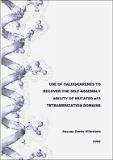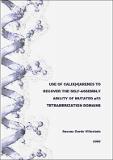Por favor, use este identificador para citar o enlazar a este item:
http://hdl.handle.net/10261/23261COMPARTIR / EXPORTAR:
 SHARE
BASE SHARE
BASE
|
|
| Visualizar otros formatos: MARC | Dublin Core | RDF | ORE | MODS | METS | DIDL | DATACITE | |

| Campo DC | Valor | Lengua/Idioma |
|---|---|---|
| dc.contributor.advisor | Giralt, Ernest | en_US |
| dc.contributor.author | Gordo Villoslada, Susana | - |
| dc.date.accessioned | 2010-04-19T10:39:42Z | - |
| dc.date.available | 2010-04-19T10:39:42Z | - |
| dc.date.issued | 2008 | - |
| dc.identifier.isbn | 978-84-691-5772-5 | - |
| dc.identifier.other | B.42818-2008 | - |
| dc.identifier.uri | http://hdl.handle.net/10261/23261 | - |
| dc.description | Tesis del Departament de Química Orgànica de la Universitat de Barcelona (UB).-- Fecha de defensa 30-06-2008. | en_US |
| dc.description.abstract | [EN] Protein-protein interactions are essential in biological processes and thus, they have become very promising therapeutic targets. Nevertheless, the artificial modulation of protein complexes remains a challenge. Since most work to date has been focused on the inhibition of protein-protein interactions, there is little precedent on the design of molecules which can induce, stabilize or recover the oligomerization state of proteins. In this context, the system comprised of the tetramerization domain of protein p53 (p53TD) and its oncogenic mutants with defective oligomerization properties is an outstanding case of study for the design and evaluation of molecules which can recover the tetrameric structure | en_US |
| dc.description.abstract | Through a collaboration with Prof. Javier de Mendoza, a family of para-guanidinomethyl-calix[4]arenes able to interact simultaneously with the four monomers of the p53 tetramerization domain was rationally designed; hence, the interaction with these compounds would stabilize the whole tetrameric assembly. In order to evaluate experimentally said calix[4]arenes, three natural oncogenic mutants of the p53TD with defective assembly abilities were biosynthesized. Namely, they are: G334V, R337H and L344P. | en_US |
| dc.description.abstract | Once synthesized and purified the calix[4]arenes compounds, their molecular recognition properties were tested through a battery of biophysical techniques, including nuclear magnetic resonances (on both the protein and the ligand), circular dichroism, differential scanning calorimetry, crystallography, mass spectrometry and chemical cross-linking. The results clearly show that these calix[4]arenes interact with the proteins as intended and, the most important, they can thermally and kinetically stabilize the tetrameric state. | en_US |
| dc.description.abstract | These results are the perfect evidence of the proof-of-concept initially sought: a little synthetic ligand can stabilize the oligomeric state of proteins which are structurally defective. In addition, the study of several ligands with different functionalizations provides further understanding about the basis of molecular recognition events. On the one hand, the guanidinium group has a vital role for high affinity interactions. On the other hand, structural flexibility, in both the protein and the ligand, enables the molecules to adopt the optimal conformation for the tightest interaction, thereby underscoring the ambiguous and unpredictable role of the entropy in interaction processes. | en_US |
| dc.description.abstract | [ES] Las interacciones proteína-proteína son esenciales en muchos procesos biológicos y por ello resultan dianas terapéuticas muy prometedoras. Sin embargo, modular artificialmente complejos proteicos resulta todavía un gran reto. Hasta la fecha, los esfuerzos se han dirigido básicamente hacia la inhibición de interacciones proteína-proteína; pocos precedentes describen el diseño de moléculas que puedan inducir, estabilizar o recuperar el estado oligomérico de proteínas. En relación a lo último, el sistema formado por el dominio de tetramerización de la proteína p53 (p53TD) y sus mutantes oncogénicos con oligomerización defectuosa representa un excelente modelo para el diseño y la evaluación de moléculas que puedan recuperar el estado tetramérico nativo. | en_US |
| dc.description.abstract | En colaboración con el Prof. Javier de Mendoza, se diseñaron racionalmente compuestos para-guanidinometil-calix[4]arenos capaces de interaccionar con simultáneamente con las cuatros unidades que estructuran el dominio de tetramerización de p53, de tal modo que podrían estabilizar el estado oligomérico de la proteína. Para la evaluación experimental de dichos ligandos calix[4]arenos, se biosintetizaron tres mutantes naturales de p53TD con tetramerización defectuosa: G334V, encontrado en cánceres de pulmón; R337H, asociado al carcinoma adrenocortical infantil; y L344P, asociado al síndrome Li-Fraumeni. | en_US |
| dc.description.abstract | Tras la síntesis y purificación de los compuestos guanidinometil-calix[4]arenos, sus capacidades de interacción con las proteínas se estudiaron por técnicas biofísicas, que incluyen resonancia magnética nuclear (sobre la proteína y sobre el ligando), dicroismo circular, calorimetría diferencial de barrido, calorimetría isotérmica de titulación, cristalografía, espectrometría de masas y entrecruzamiento químico. Los resultados muestran claramente que los calix[4]arenos pueden interaccionar con las proteínas tal y como se habían diseñado; en consecuencia, estos ligandos son capaces de estabilizar térmica y cinéticamente las proteínas mutantes, recuperando así su estado tetramérico. | en_US |
| dc.description.abstract | Estos resultados son la perfecta prueba del concepto inicialmente planteado: un pequeño ligando sintético diseñado puede estabilizar el estado oligomérico de proteínas estructuralmente defectuosas. El estudio de varios ligandos con diferentes grupos funcionales también pone de manifiesto otros fenómenos de particular relevancia en el campo del reconocimiento de superficies proteicas. Por una parte, el grupo guanidinio tiene un papel clave para la afinidad de la interacción. Por otra parte, la flexibilidad estructural de ambos componentes: la proteína y el ligando, permite que se establezcan interacciones más estrechas y fuertes, lo que refleja el papel tan ambiguo e impredecible de la entropía en procesos de interacción. | en_US |
| dc.format.extent | 1947742 bytes | - |
| dc.format.extent | 8168136 bytes | - |
| dc.format.extent | 4439925 bytes | - |
| dc.format.extent | 6581712 bytes | - |
| dc.format.extent | 4032881 bytes | - |
| dc.format.extent | 3922134 bytes | - |
| dc.format.extent | 1681558 bytes | - |
| dc.format.extent | 1845584 bytes | - |
| dc.format.extent | 1413128 bytes | - |
| dc.format.extent | 997023 bytes | - |
| dc.format.extent | 5989888 bytes | - |
| dc.format.mimetype | application/pdf | - |
| dc.format.mimetype | application/pdf | - |
| dc.format.mimetype | application/pdf | - |
| dc.format.mimetype | application/pdf | - |
| dc.format.mimetype | application/pdf | - |
| dc.format.mimetype | application/pdf | - |
| dc.format.mimetype | application/pdf | - |
| dc.format.mimetype | application/pdf | - |
| dc.format.mimetype | application/pdf | - |
| dc.format.mimetype | application/pdf | - |
| dc.format.mimetype | application/pdf | - |
| dc.language.iso | eng | en_US |
| dc.publisher | Universidad de Barcelona | en_US |
| dc.rights | openAccess | en_US |
| dc.subject | Interaccions proteïna-proteïna | en_US |
| dc.subject | Dianes terapèutiques | en_US |
| dc.subject | Complexos proteics | en_US |
| dc.subject | Tetramerització | en_US |
| dc.subject | Proteïna p53 | en_US |
| dc.title | Use of calix[4]arenes to recover the self-assembly ability of mutated p53 tetramerization domains | en_US |
| dc.type | tesis doctoral | en_US |
| dc.description.peerreviewed | Peer reviewed | en_US |
| dc.relation.publisherversion | http://www.tdx.cat/TDX-0714108-115241 | en_US |
| dc.type.coar | http://purl.org/coar/resource_type/c_db06 | es_ES |
| item.languageiso639-1 | en | - |
| item.fulltext | With Fulltext | - |
| item.openairecristype | http://purl.org/coar/resource_type/c_18cf | - |
| item.cerifentitytype | Publications | - |
| item.grantfulltext | open | - |
| item.openairetype | tesis doctoral | - |
| Aparece en las colecciones: | (IQAC) Tesis | |
Ficheros en este ítem:
| Fichero | Descripción | Tamaño | Formato | |
|---|---|---|---|---|
| Gordo_Susana_1.pdf | Índices | 1,9 MB | Adobe PDF |  Visualizar/Abrir |
| Gordo_Susana_2.pdf | Introducción | 7,98 MB | Adobe PDF |  Visualizar/Abrir |
| Gordo_Susana_3.pdf | Resultados 1 | 4,34 MB | Adobe PDF |  Visualizar/Abrir |
| Gordo_Susana_4.pdf | Resultados 2 | 6,43 MB | Adobe PDF |  Visualizar/Abrir |
| Gordo_Susana_5.pdf | Resultados 3 | 3,94 MB | Adobe PDF |  Visualizar/Abrir |
| Gordo_Susana_6.pdf | Resultados 4 | 3,83 MB | Adobe PDF |  Visualizar/Abrir |
| Gordo_Susana_7.pdf | Conclusiones | 1,64 MB | Adobe PDF |  Visualizar/Abrir |
| Gordo_Susana_8.pdf | Parte experimental | 1,8 MB | Adobe PDF |  Visualizar/Abrir |
| Gordo_Susana_9.pdf | Resumen | 1,38 MB | Adobe PDF |  Visualizar/Abrir |
| Gordo_Susana_10.pdf | Apéndices | 973,66 kB | Adobe PDF |  Visualizar/Abrir |
| Gordo_Susana_11.pdf | Material suplementario | 5,85 MB | Adobe PDF |  Visualizar/Abrir |
CORE Recommender
Page view(s)
318
checked on 24-abr-2024
Download(s)
1.491
checked on 24-abr-2024
Google ScholarTM
Check
Altmetric
NOTA: Los ítems de Digital.CSIC están protegidos por copyright, con todos los derechos reservados, a menos que se indique lo contrario.
